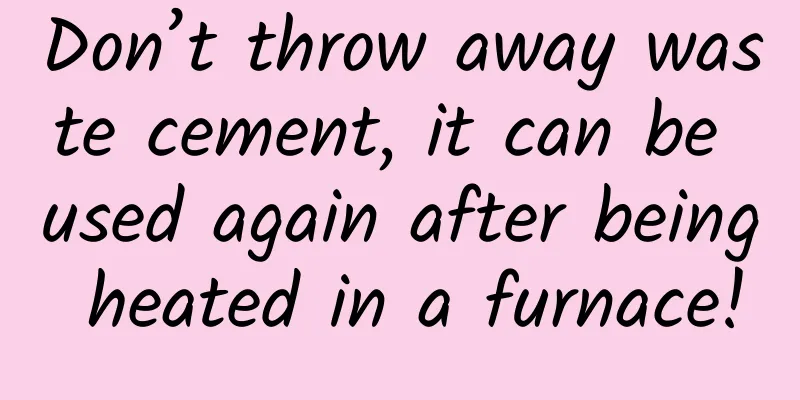Don’t throw away waste cement, it can be used again after being heated in a furnace!

|
□ Right to speak Using electric-powered furnaces to produce steel is a mature technology. If waste cement is used as part of steel production, it can be reused. If it is heated in an electric arc furnace powered by renewable energy, we can get zero-emission cement. Recently, researchers at the University of Cambridge in the UK drew inspiration from traditional iron smelting furnaces and proved for the first time in the world that cement can be recycled without causing harm to the environment like the previous production of synthetic cement. The relevant research results were recently published in the international scientific journal Nature. Concrete is a material that is used in large quantities. In addition to sand and gravel, its main components are cement, which acts as a binder. Limestone and other raw materials are crushed and heated to about 1450°C in large kilns. This process converts the raw materials into cement. In the process of heating to produce quicklime, limestone releases a large amount of carbon dioxide, accounting for about 7.5% of total anthropogenic emissions. Over the past 10 years, scientists have been studying cement substitutes in concrete and found that about half of the cement in concrete can be replaced with materials such as fly ash, but it is unrealistic to completely eliminate cement. How to adopt cost-effective methods to reduce carbon emissions from concrete is one of the world's biggest carbon reduction challenges. In the process of blast furnace ironmaking, in order to reduce the smelting temperature, an appropriate amount of limestone and dolomite are added as flux. These limestone and dolomite are decomposed into calcium oxide, magnesium oxide, iron ore and other substances in the blast furnace, and melted with the ash powder in the coke to form a molten material with silicate and aluminosilicate as the main components, which floats on the surface of the molten iron and is discharged from the slag outlet regularly. It is then cooled by air or water to form granular particles, which is slag. The waste slag produced when the steel plant smelts pig iron contains a large amount of glass and minerals such as dicalcium silicate, calcite, and wollastonite, which are close to the composition of cement. The mineral form of slag that has not been quenched by water is a stable crystal, and most of it is inactive. If it is quenched by water and rapidly cooled, it forms a glassy structure, which makes the slag unstable and has greater potential chemical energy. The higher the slag discharge temperature and the faster the cooling rate, the greater the potential chemical energy of the vitrified slag and the higher the activity. Therefore, the potential activity of blast furnace slag that has been quenched by water and rapidly cooled is better, and 0.3-1 tons of slag should be discharged for every ton of pig iron produced. Slag treatment is the guarantee for the normal operation of blast furnace ironmaking. High-quality slag can be used as high-quality raw material for cement, which can not only reduce costs and improve economic benefits, but also be conducive to the utilization of bulk solid waste, the development of circular economy and environmental protection. Researchers at the University of Cambridge in the UK adjusted the existing steel production process and found that the chemical composition of waste cement is similar to that of limestone. If waste cement is used instead of limestone and added to the ironmaking furnace, the slag produced can be used to make new cement. In this way, cement can be recycled, not only does not require the production of so much new cement, but also reduces carbon dioxide pollution. (The author is a member of Anhui Science Writers Association) |
Recommend
Can pets cause lung cancer? People who keep such pets at home should pay attention...
How does the doctor know what disease I have? To ...
Effects and functions of traditional Chinese medicine fried white atractylodes
Fried Atractylodes macrocephala with bran has man...
The efficacy and function of creeping dragon
There are so many medicinal herbs in the world, a...
Proposing with a concrete ring, who says tech guys don't understand romance
Who says tech guys don’t understand romance? Rece...
A woman used a massager to lose weight and her kidneys were "flattened" and she was sent to the ICU. Don't try these 11 weight loss methods!
Recently, a #woman in Huizhou, Guangdong used a m...
Cynomorium songaricum efficacy and function pictures
Cynomorium songaricum is a commonly used traditio...
Plant a dam and “water” a friend!
March brings everything back to life Planting flo...
The efficacy and function of Prunella Vulgaris Dew
The efficacy and function of the traditional Chin...
What are the effects and functions of Gangbangui?
The herb can play a very good antibacterial role,...
It took several weeks to remove the parasite from the patient's body.
The species calendar I wrote before was about the...
Do you want to soak lily?
Patients with rhinitis should never smell lilies,...
The efficacy and function of the traditional Chinese medicine Uncaria rhynchophylla
The Chinese medicinal herb Uncaria rhynchophylla ...
“Double-peak La Niña” is coming, will you be frozen to tears this winter?
From November 4 to 8, my country just experienced...
Medicinal value of xianlingpi
Many male friends will drink a lot of alcohol to ...
The efficacy and function of wolfberry root
The root of wolfberry is actually what people oft...









